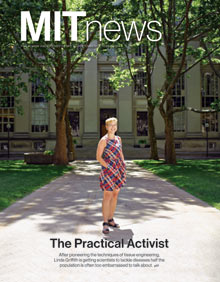Letters
A Brilliant, Passionate Scientist
There are very few life-changing moments in one’s career, and I am privileged to describe the moment I met Linda Griffith as one of those (“The Practical Activist,” September/October 2014). Through my work at MGH, I was introduced to Linda by Dr. Jay Vicante, her collaborator and friend. Jay described Linda as a brilliant, passionate scientist at MIT who was a star in the field of tissue engineering. I had been involved in basic and clinical research in endometriosis, and I explained to Linda the need for an in vitro model to study the disease. Linda is not an easy person to convince, but eventually, she agreed to direct the MIT Center for Gynepathology Research for this purpose.

Having worked with Linda now for five years as clinical co-director of the center, I can say that Dr. Vicante’s description was an understatement. Linda has the unique ability to excite her students and collaborators with her own passion and beliefs. Because she is able to translate difficult basic scientific problems into a language that clinicians can understand, I had invited Linda to speak at a large international surgical meeting in 2011. Her understanding of the disease and her concern for patient care have landed her an invitation to speak at this annual meeting on an ongoing basis.
It is rare for a clinical surgeon such as myself to look forward to laboratory meetings. Without hesitation, I can say I learn from Linda every time we get together. I have no doubt that under her direction, the Center for Gynepathology Research will make large strides toward finding the cause of the debilitating disease of endometriosis and developing a cure.
Keith Isaacson, MD
Newton, Massachusetts
As a longtime colleague and collaborator of Professor Linda Griffith, I was delighted and surprised to read the profile of her work. I was delighted because she is one of my personal role models in science, and I was surprised because I’ve never really thought of Linda as an activist. When she inspired me to study endometriosis, it felt nothing like “activism.” Instead, Linda’s bold vision that a few of us working together can make a big difference in patient’s lives, her natural charisma, and her proven track record as a scientist are what motivated me to follow her into this and many other endeavors.
Eric Alm
Associate professor of biological engineering, MIT
Megatons to Megawatts
Congratulations on Anne-Marie Corley’s superb article (“A Farewell to Arms,” September/October 2014) on the 1993–2013 U.S.-Russian Megatons to Megawatts agreement, which provided for the sale of highly enriched uranium from dismantled Soviet nuclear weapons for use in civil power reactors in the United States. I was especially pleased that the article highlighted the unique, pivotal role played by Tom Neff in proposing the HEU deal, pushing the United States and Russia to negotiate and implement it, and helping to find solutions from behind the scenes when it appeared to be falling off track.
I recall an interaction with Neff that took place in 1991, when I was working at the State Department as deputy director of the Office of Nuclear Export Control and Nonproliferation Policy. After reading Neff’s op-ed piece in the New York Times proposing that the United States buy the HEU and get it converted to low-enriched uranium for sale in the U.S. for power reactors, I called him to ask about it. I had no technical background and had no idea that highly enriched uranium could be made into low-enriched uranium. After much discussion, I saw that it was potentially a “swords to ploughshares” project that could work commercially.
At the end of the phone call I remarked to Neff that I assumed his phone had been ringing off the hook in response to the op-ed piece. He replied, “Not really. No one has called.”
Ellie Busick
Falls Church, Virginia
Thomas Neff is right that the megatons to Megawatts program was a product of its time—probably not possible these days, with relations between Russia and the United States at a new low. But it is interesting that another major joint program born in the 1990s has managed to transcend its particular historical moment: the International Space Station. It too was driven by concerns among U.S. policy analysts that Russian scientists and engineers might sell their skills to unfriendly nations. One way to secure their employment in a “safe” direction was to coöperate in space. Amazingly, that arrangement continues to thrive today despite the vicissitudes of the U.S.-Russia relationship.
Asif Siddiqi
Professor of history, Fordham University
Bronx, New York
The story of how MIT researcher Thomas Neff came up with the idea to repurpose Russian weapons-grade uranium as fuel for U.S. power plants is a perfect example of “Mens et Manus” in action. This was probably one of the most successful nonproliferation agreements ever.
Damian Fernandez Lamela, MBA ’07
Addison, Texas
Keep Reading
Most Popular
Large language models can do jaw-dropping things. But nobody knows exactly why.
And that's a problem. Figuring it out is one of the biggest scientific puzzles of our time and a crucial step towards controlling more powerful future models.
The problem with plug-in hybrids? Their drivers.
Plug-in hybrids are often sold as a transition to EVs, but new data from Europe shows we’re still underestimating the emissions they produce.
Google DeepMind’s new generative model makes Super Mario–like games from scratch
Genie learns how to control games by watching hours and hours of video. It could help train next-gen robots too.
How scientists traced a mysterious covid case back to six toilets
When wastewater surveillance turns into a hunt for a single infected individual, the ethics get tricky.
Stay connected
Get the latest updates from
MIT Technology Review
Discover special offers, top stories, upcoming events, and more.